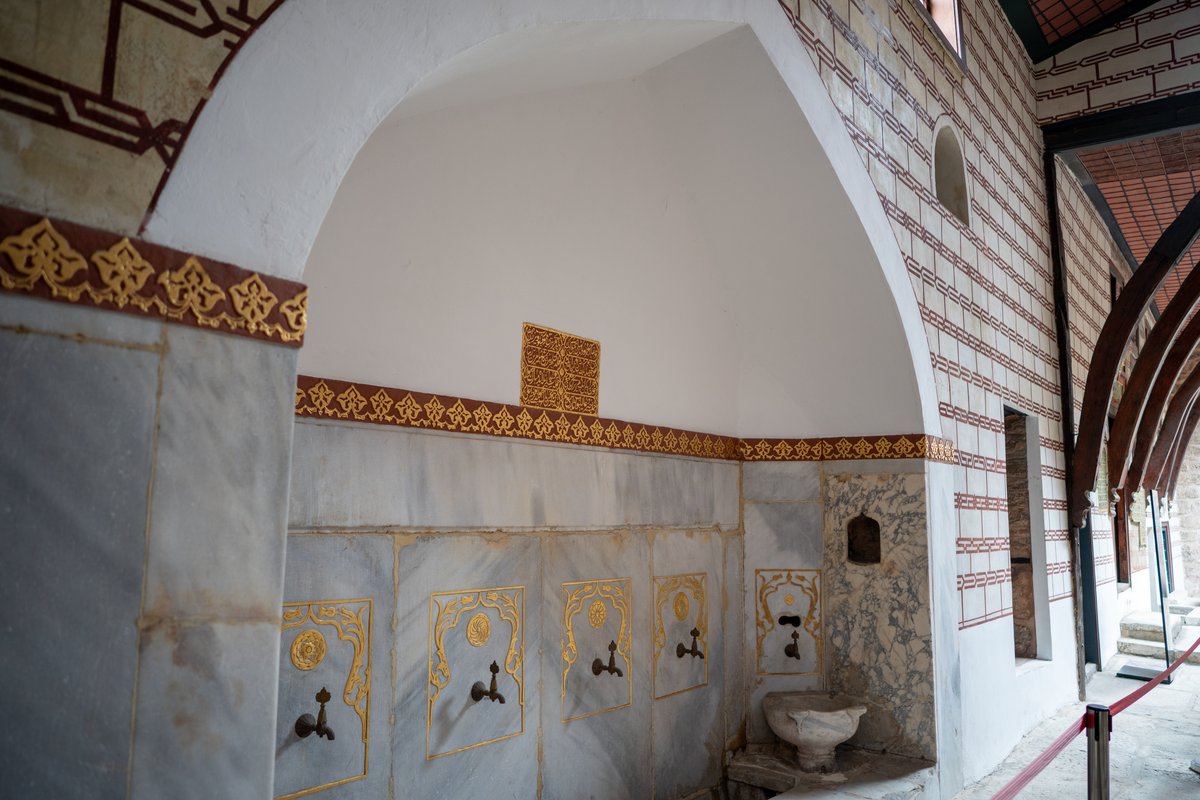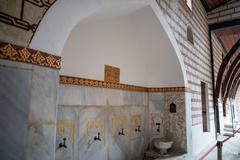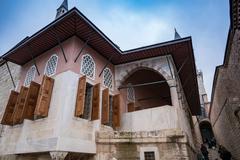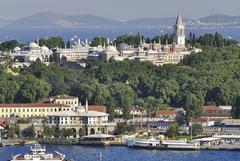
Topkapı Sarayı Visiting Hours, Tickets, and Historical Significance
Date: 16/07/2024
Introduction
Topkapı Sarayı, or Topkapı Palace, stands as one of Istanbul’s most iconic historical landmarks and a symbol of the grandeur of the Ottoman Empire. Commissioned by Sultan Mehmed II in 1459, shortly after his conquest of Constantinople, the palace served as the primary residence of Ottoman sultans for nearly 400 years (UNESCO). Strategically located between the Golden Horn and the Sea of Marmara, the palace offers stunning views and rich historical significance, blending Ottoman, Islamic, and Byzantine architectural elements (ArchNet). Over the centuries, the palace complex expanded significantly, with additions like the Harem, the Imperial Treasury, and the Privy Chamber, showcasing the empire’s diverse cultural heritage and opulence. Today, Topkapı Sarayı is a museum, transformed after the establishment of the Republic of Turkey in 1924, allowing visitors to explore its rich history and cultural legacy (Topkapı Palace Museum). This comprehensive guide aims to provide all the essential information for a memorable visit, including historical context, visitor tips, and nearby attractions.
Table of Contents
- Introduction
- Foundation and Early Years
- Expansion and Renovations
- Decline and Transformation
- Visitor Information
- Travel Tips
- Nearby Attractions
- Special Events
- Accessibility
- Conclusion
- FAQ
Discover the Rich History and Visitor Information of Topkapı Sarayı in Istanbul
Foundation and Early Years
Topkapı Sarayı was commissioned by Sultan Mehmed II in 1459, shortly after his conquest of Constantinople in 1453. The palace was constructed on the site of the ancient Byzantine acropolis, strategically located between the Golden Horn and the Sea of Marmara. This location not only provided a commanding view of the Bosphorus Strait but also symbolized the Ottoman Empire’s dominance over both Europe and Asia.
The initial construction phase of the palace was completed in 1478. The complex was designed to serve as the primary residence and administrative headquarters of the Ottoman sultans. The architectural style of the palace reflects a blend of Ottoman, Islamic, and Byzantine influences, showcasing the empire’s diverse cultural heritage.
Expansion and Renovations
Over the centuries, Topkapı Sarayı underwent numerous expansions and renovations. Each sultan who resided in the palace contributed to its development, adding new buildings, courtyards, and gardens. Notable additions include the Harem, the Imperial Treasury, and the Privy Chamber.
One of the most significant expansions occurred during the reign of Sultan Suleiman the Magnificent (1520-1566). Under his rule, the palace complex was significantly enlarged, and many of its most iconic structures were built. The Harem, a secluded area reserved for the sultan’s family and concubines, was expanded to accommodate the growing royal household. The Imperial Treasury, which houses some of the most valuable artifacts of the Ottoman Empire, was also established during this period.
The Harem
The Harem of Topkapı Sarayı is one of the most intriguing and mysterious parts of the palace. It was a private domain where the sultan’s wives, concubines, and children lived, along with the eunuchs who served them. The Harem was a self-contained community with its own rules and hierarchy.
The Harem’s architecture is a testament to the opulence and sophistication of the Ottoman court. It consists of a series of interconnected rooms, courtyards, and passageways, adorned with intricate tilework, calligraphy, and stained glass windows. The most important rooms in the Harem include the Queen Mother’s Apartments, the Sultan’s Apartments, and the Courtyard of the Favorites.
The Imperial Council
The Imperial Council, or Divan-ı Hümayun, was the central governing body of the Ottoman Empire, and it held its meetings in the Council Hall of Topkapı Sarayı. The council was composed of the sultan’s top advisors, including the Grand Vizier, who was the head of the council and the second most powerful person in the empire after the sultan.
The Council Hall, also known as the Kubbealtı, is an impressive structure with a domed ceiling and ornate decorations. It was here that the most important decisions regarding the administration, military, and foreign policy of the empire were made. The council met regularly to discuss state affairs, and the sultan would often listen to the proceedings from a hidden chamber known as the Window of the Sultan.
The Imperial Treasury
The Imperial Treasury of Topkapı Sarayı is one of the most fascinating parts of the palace. It houses a vast collection of priceless artifacts, including jewels, weapons, and religious relics. The treasury is divided into several rooms, each dedicated to a different category of items.
One of the most famous items in the treasury is the Topkapı Dagger, a jewel-encrusted weapon that is considered one of the finest examples of Ottoman craftsmanship. Another notable artifact is the Spoonmaker’s Diamond, an 86-carat diamond that is one of the largest in the world. The treasury also contains a collection of sacred relics, including the Prophet Muhammad’s cloak and sword.
Decline and Transformation
By the 17th century, the Ottoman Empire began to decline, and the sultans gradually moved their primary residence to the newer Dolmabahçe Palace on the shores of the Bosphorus. Despite this shift, Topkapı Sarayı remained an important ceremonial and administrative center until the fall of the Ottoman Empire in the early 20th century.
In 1924, following the establishment of the Republic of Turkey, Topkapı Sarayı was transformed into a museum by the order of Mustafa Kemal Atatürk, the founder of modern Turkey. The palace was opened to the public, allowing visitors to explore its rich history and cultural heritage.
Visitor Information
To make the most of your visit to Topkapı Sarayı, here are some essential details:
- Visiting Hours: The palace is open from 9:00 AM to 6:00 PM, with the last entry at 5:00 PM. It is closed on Tuesdays.
- Ticket Prices: General admission is 200 Turkish Lira, with additional fees for the Harem and the Hagia Irene. Discounts are available for students and groups.
- Guided Tours: Guided tours are available in multiple languages and can provide deeper insights into the palace’s history and significance.
Travel Tips
- Best Times to Visit: The best times to visit are early in the morning or late in the afternoon to avoid the crowds. Spring and autumn offer the most pleasant weather.
- How to Get There: Topkapı Sarayı is easily accessible by public transport. The nearest tram stop is Gülhane on the T1 line. It is also within walking distance from the Hagia Sophia and the Blue Mosque.
- Amenities: There are cafés and restrooms available within the palace grounds. It is advisable to wear comfortable shoes as the complex is extensive and involves a lot of walking.
Nearby Attractions
While visiting Topkapı Sarayı, consider exploring other historical sites in Istanbul:
- Hagia Sophia: Just a short walk away, this architectural marvel has served as both a church and a mosque and is now a museum (Hagia Sophia).
- Blue Mosque: Known for its stunning blue tiles, this mosque is another must-see site in Sultanahmet (Blue Mosque).
- Basilica Cistern: An ancient underground water reservoir with impressive columns and atmospheric lighting (Basilica Cistern).
Special Events
Topkapı Sarayı occasionally hosts special exhibitions and events. Check the palace’s official website or inquire at the entrance for information on current and upcoming events.
Accessibility
Topkapı Sarayı is partially accessible to visitors with disabilities. Ramps and elevators are available in some areas, but certain parts of the palace may be challenging to navigate. It is recommended to contact the palace in advance to discuss specific accessibility needs.
Conclusion
Topkapı Sarayı offers a unique glimpse into the opulent lifestyle of the Ottoman sultans and the grandeur of their empire. With its rich history, stunning architecture, and invaluable artifacts, the palace is a must-visit destination for anyone interested in Istanbul’s cultural heritage. Plan your visit today to experience the splendor of Topkapı Sarayı firsthand.
For more detailed information on the history and significance of Topkapı Sarayı, you can visit the official Topkapı Palace Museum website.
FAQs
What are the Topkapı Palace visiting hours?
- The palace is open from 9:00 AM to 6:00 PM, with the last entry at 5:00 PM. It is closed on Tuesdays.
How much are tickets to Topkapı Sarayı?
- General admission is 200 Turkish Lira, with additional fees for the Harem and the Hagia Irene. Discounts are available for students and groups.
Are guided tours available at Topkapı Palace?
- Yes, guided tours are available in multiple languages and can provide deeper insights into the palace’s history and significance.
What are some nearby attractions to Topkapı Sarayı?
- Nearby attractions include the Hagia Sophia, the Blue Mosque, and the Basilica Cistern.
Is Topkapı Sarayı accessible to visitors with disabilities?
- The palace is partially accessible, with ramps and elevators in some areas. It is recommended to contact the palace in advance for specific accessibility needs.
References
- UNESCO, 2024 whc.unesco
- ArchNet, 2024 archnet
- Topkapı Palace Museum, 2024 topkapisarayi.gov.tr


